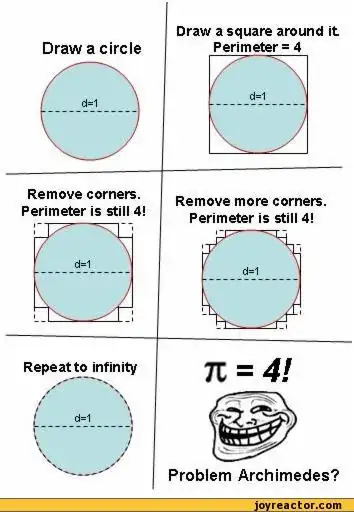I have seen a [picture like this] several times:

featuring a "troll proof" that $\pi=4$. Obviously the construction does not yield a circle, starting from a square, but how to rigorously and demonstratively prove it?
For reference, we start with a circle inscribed in a square with side length 1. A step consists of reflecting each corner of figure $F_i$ so that it lies precisely on the circle and yielding figure $F_{i+1}$. $F_0$ is the square with side length 1. After infinitely many steps we have a figure $F_\infty$. Prove that it isn't a circle.
Possible ways of thinking:
- Since the perimeter of figure $F_i$ indeed does not change during a step, it is invariant. Since it does not equal the perimeter of the circle, $\pi\neq4$, it cannot be a circle.
While it seems to work, I do not find this proof demonstrative enough - it does not show why $F_\infty$ which looks very much like a circle to us, is not one.
- Consider one corner of the square $F_0$. Let $t$ be a coordinate along the edge of this corner, $0 \leq t \leq 1$ and $t=0, t=1$ being the points of tangency for this corner of $F_0$ and the circle. By construction, all points $t \in A=\{ \frac{n}{2^m} | (n,m\in \mathbb{N}) \& (n<2^m)\}$ of $F_\infty$ lie on the circle. I think it can be shown that the rest of the points, $\bar{A}=[0;1] \backslash A$, lie in an $\varepsilon$-neighbourhood $U$ of the circle. I also think that in the limit $\varepsilon \to 0$, points $ t\in\bar{A}$ also lie on the circle. Am I wrong in thinking this? Can we get a contradiction from this line of thought?
Any other elucidating proofs and thoughts are also welcomed, of course.